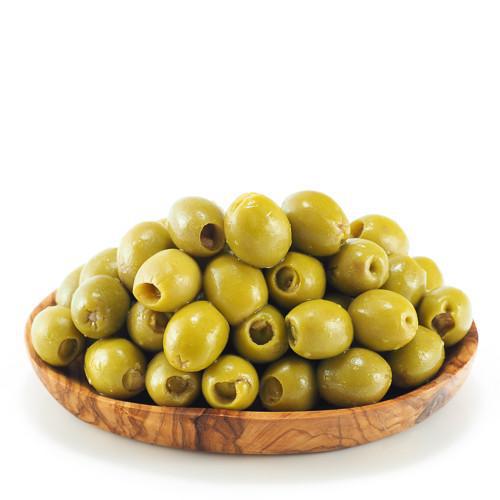

About Olives
The olive is a species of small tree in the family Oleaceae, native to the coastal areas of the eastern Mediterranean Basin as well as northern Iraq, and northern Iran at the south of the Caspian Sea.
Its fruit, also called the olive, is of major agricultural importance in the Mediterranean region as the source of olive oil. The tree and its fruit give its name to the plant family, which also includes species such as lilacs, jasmine, Forsythia and the true ash trees (Fraxinus). The word derives from Latin ol?va which is cognate with the Greek ?λα?α (elaía) ultimately from Mycenaean Greek e-ra-wa("elaiva"), attested in Linear B syllabic script. The word "oil" in multiple languages ultimately derives from the name of this tree and its fruit.
History
The olive is one of the plants most often cited in western literature. In Homer’s Odyssey, Odysseus crawls beneath two shoots of olive that grow from a single stock, and in the Iliad, is a metaphoric description of a lone olive tree in the mountains, by a spring; the Greeks observed that the olive rarely thrives at a distance from the sea, which in Greece invariably means up mountain slopes. Greek myth attributed to the primordial culture-hero Aristaeus the understanding of olive husbandry, along with cheese-making and bee-keeping. Olive was one of the woods used to fashion the most primitive Greek cult figures, called xoana, referring to their wooden material; they were reverently preserved for centuries. It was purely a matter of local pride that the Athenians claimed that the olive grew first in Athens. In an archaic Athenian foundation myth, Athena won the patronship of Attica from Poseidon with the gift of the olive. Though, according to the 4th-century BC father of botany, Theophrastus, olive trees ordinarily attained an age of about 200 years, he mentions that the very olive tree of Athena still grew on the Acropolis; it was still to be seen there in the 2nd century AD; and when Pausanias was shown it, ca 170 AD, he reported "Legend also says that when the Persians fired Athens the olive was burnt down, but on the very day it was burnt it grew again to the height of two cubits." Indeed, olive suckers sprout readily from the stump, and the great age of some existing olive trees shows that it was perfectly possible that the olive tree of the Acropolis dated to the Bronze Age. The olive was sacred to Athena and appeared on the Athenian coinage.
Our suppliers are located in Greece and Spain as they are grown in quality controlled environment. Below you will find all the packages which we can supply:
|
PACKAGE |
WHOLE OLIVES (kg) GROSS/NET |
PITTED OLIVES WEIGHT (kg) GROSS/NET |
SILICED OLIVES WEIGHT (kg) GROSS/NET |
STUFFED OLIVES WEIGHT (kg) GROSS/NET |
CARTONS |
CARTONS / PALLET |
|
Glass Jar 370ml |
0.58kg / 0.2kg |
0.58kg / 0.18kg |
0.58kg / 0.18kg |
0.58kg / 0.2kg |
12 |
130 |
|
Glass Jar 720ml |
1kg / 0.42kg |
1kg / 0.36kg |
1kg/ 0.36kg |
1kg / 0.42kg |
12 |
75 |
|
Glass Jar 1000ml |
1.48/0.59kg |
1.48kg/0.50kg |
1.48kg/0.50kg |
1.48kg /0.53kg |
6 |
84 |
|
Pet jar 0.5LT |
0.6kg /0.3kg |
0.6kg/0.25kg |
0.6kg/0.25kg |
0.6kg /0.3kg |
12 |
100 |
|
Pet jar 1LT |
1.2kg /0.6kg |
1.2kg/0.52kg |
1.2kg/0.52kg |
1.2kg /0.6kg |
6 |
128 |
|
Pet jar 1.5LT |
1.8kg /1kg |
1.8kg/0.8kg |
1.8kg/0.8kg |
1.8kg /0.9kg |
6 |
54 |
|
Pet jar 5L |
5.5kg /3kg |
5.5kg/2.7kg |
5.5kg/2.7kg |
5,5kg /3kg |
4 |
24 |
|
Tin 5LT |
4.4kg /2.5kg |
4.4kg/2kg |
4.4kg/2kg |
|
|
175 |
|
Tin 9LT |
9kg /5kg |
9kg/4kg |
9kg/4kg |
9kg /4kg |
|
100 |
|
Tin 21LT |
21kg /13kg |
21kg/10kg |
21kg/10kg |
21kg /10kg |
|
45 |
|
Plastic 1.6LT |
1.8kg /1kg |
1.8kg/0.9kg |
1.8kg/0.9kg |
1.8kg /1kg |
6 |
54 |
|
Plastic 3.3LT |
3.6/2kg |
3.6kg/1.9kg |
3.6kg/1.9kg |
3.6kg /2kg |
6 |
25 |
|
Plastic 9LT |
9kg /5kg |
9kg/4kg |
9kg/4kg |
9kg /5kg |
2 |
40 |
|
Plastic 20LT |
21kg /12kg |
21kg/11kg |
21kg/11kg |
21kg /12kg |
|
30 |
|
Plastic 220LT |
235kg /150kg |
235kg/130kg |
235kg/130kg |
235kg /140kg |
|
Sizes
Olive sizes are rated by the quantity of units per KG, with a tolerance of 10, 20 or 30 units. For instance, when we say 181/200, it means that one kilo of olives contains approximately 190 olives.
|
Olive Sizes |
Olives per kilo |
|
S.S. Mammoth |
70 / 90 |
|
S. Mammoth |
91 / 100 |
|
Mammoth |
101 / 110 |
|
S. Colossal |
111/ 120 |
|
Colossal |
|
|
Giants |
141 / 160 |
|
Extra Jumbo |
161 / 180 |
|
Jumbo |
181 / 200 |
|
Extra Large |
201 / 230 |
|
Large |
231 / 260 |
|
Superior |
261 / 290 |
|
Brilliant |
291 / 320 |
|
Fine |
321 / 250 |
|
Bullets |
351 / 380 |
More details:View company website
Its Free
Verify Now